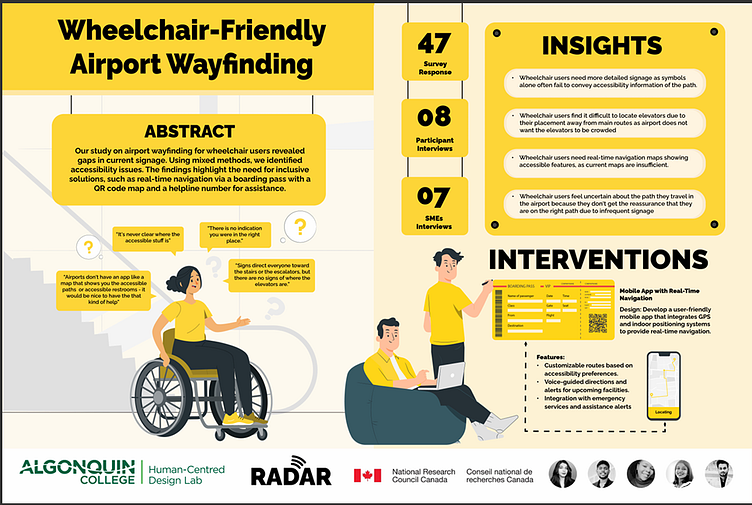Enhancing Wayfinding Signage for Wheelchair users.
Navigating Airports – Enhancing Wayfinding Signage for Wheelchair Users
Project Overview
Objective:
Our project aimed to improve airport navigation for wheelchair users by addressing accessibility issues in wayfinding signage and exploring digital solutions like the NavEase app for real-time navigation assistance.
Problem Statement
Navigating airports can be challenging for wheelchair users due to visibility issues, inaccessible paths, and cognitive overload in high-stress environments. This project focused on understanding these barriers and creating inclusive design solutions to make airports more navigable for individuals with mobility impairments.
Research Process
1. Background & Literature Review
We explored cognitive and environmental factors affecting wayfinding, focusing on high-stress environments like airports. The research highlighted:
Visibility & Placement Issues – Signs were often not visible from a seated position, and accessible paths were poorly marked.
Stress Impact on Cognition – High stress impacts cognitive abilities such as decision-making.
Technological Innovations – Technologies like AR and VR could potentially support accessible, real-time guidance.
Research & Insights
2. Research Questions
Guided by questions like, “How does current airport signage affect wheelchair users’ wayfinding experiences?” our study aimed to identify challenges and explore the potential for technological solutions.
3. Data Collection
We employed a mixed-methods approach:
Survey: Gathered insights on navigational preferences and pain points from wheelchair users.
Interviews: Conducted with wheelchair users and Subject Matter Experts (SMEs).
Recruitment Methods: We collaborated with accessibility organizations and utilized social media and word-of-mouth outreach.
Design & Ideation
4. Journey Mapping
(https://miro.com/app/board/uXjVK1kNP3U=/?moveToWidget=3458764596489555833&cot=14)
A journey map illustrated Raha and Sarah’s experiences navigating airports. This map highlighted touchpoints, emotions, and pain points throughout their travel journey, revealing opportunities for solutions like clearer, more frequent signage and real-time navigation aids.
Solution Phases: Short-, Mid-, and Long-Term
5. We developed solutions based on effort and impact, distinguishing them as:
Short-Term: Updating static signage for visibility and readability.
Mid-Term: Partnering with tech companies to integrate wayfinding capabilities into airport apps.
Long-Term: Developing NavEase, a mobile app for real-time navigation tailored to wheelchair users’ needs
Solution Development
6. NavEase: A Digital Wayfinding Solution
NavEase was selected as the primary intervention, featuring:
Real-Time Navigation: Provides accessible paths and facility locations.
Accessibility Information: Highlights accessible elevators, bathrooms, and ramps.
Customizable Navigation: Offers both visual and auditory navigation assistance.
Offline Mode: Ensures accessibility in low-connectivity zones.
7. Validation Testing
We conducted testing sessions with SMEs and wheelchair users to refine NavEase. Key feedback included:
Real-Time Accuracy: Enhanced the app’s interface for more accurate guidance.
User Interface Design: Improved font readability and icons for accessibility.
Offline Functionality: Added an offline mode for reliable access.
Final Solution: NavEase App
Prototype and Features
(Figma Link can be viewed here: NavEase Application)
NavEase provides a comprehensive, real-time navigation solution for wheelchair users, ensuring their airport experience is safe, accessible, and independent.
Implementation & Scalability
A phased rollout, beginning with a pilot program in Ottawa, will be followed by broader implementation. NavEase is scalable, integrating with airport management systems and offering multi-language support.
Success Metrics
User Satisfaction
Efficiency of Navigation
Stress Reduction
Reflections & Impact
Key Takeaways
User-Centered Approach: Personas and journey maps were central to the solution design.
Importance of Testing & Iteration: Continuous testing refined the NavEase app based on real user needs.
Broader Implications: NavEase could be adapted to other public spaces requiring accessible navigation













